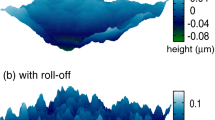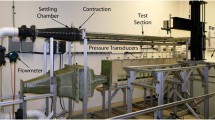Abstract
The influence of a change in the surface roughness z0 on the air flow speed over this surface is considered. It is shown that a twofold change in the parameter (from 0.01 to 0.02) results in a disturbed speed of the air flow, which attenuates both with height and distance. The maximal disturbance can amount to 30% at a height of 5 m, it is already 3–5% at a height of 40 m, and it totally disappears at a height of 100 m. In the horizontal, the disturbance can spread for 1.5–2 km. The estimates of radioactive contamination of the underlying surface, under conditions of a nuclear power enterprise accident, demonstrated that the disturbance can lead to no less than a twofold error of the area of radioactive contamination.
Similar content being viewed by others
References
N. G. Gusev and V. A. Belyaev, Radioactive Release in the Biosphere, Handbook (Energoatomizdat, Moscow, 1986) [in Russian].
A. P. Elokhin, “Selection of an Optimal Height for Meteorological Mast to Solve Problems of Predicting Radioactive Contamination of the Environment from NPP Release,” Trudy MIFI (1999) [Collected Trans. Moscow Engineering Physics Institute (1999)].
A. P. Elokhin, “Optimization of Methods and Means of Automated Systems of Management of the Environmental Radiation Situation,” Doctoral Dissertation in Mathematics and Physics (MIFI, Moscow, 1999).
A. R. Konstantinov, “Estimation of Evaporation from Agricultural Fields with Allowance for the Influence of Forest Bands,” Trudy GGI, No. 34(88) (1952) [Trans. State Hydrol. Inst., No. 34 (88) (1952)].
D. L. Laikhtman, “Wind Profile and Exchange in the Atmospheric Surface Layer,” Izv. Akad. Nauk SSSR, Ser. Geogr. Geofiz., No. 1, 8 (1944) [Izv., Ser. Geograph. and Geophys., No. 1, 8 (1944)].
D. L. Laikhtman, “Air Mass Transformation under the Influence of the Underlying Surface,” Meteorol. Gidrol., No. 1 (1947) [Meteorol. Hydrol., No. 1 (1947)].
D. L. Laikhtman, Physics of the Atmospheric Boundary Layer (Gidrometeoizdat, Leningrad, 1970) [in Russian].
D. L. Laikhtman and M. I. Yudin, “Transformation of the Lower Air Layer under the Influence of the Underlying Surface,” Dokl. Akad. Nauk SSSR, No. 2, 93 (1953) [Sov. Phys. Dokl., No. 2, 93 (1953)].
R. S. Lyapina, “Wind Profile and Roughness Parameter on the Potato Field,” Trudy GGO, No. 214 (1967) [Trans. Main Geophysical Observatory, No. 214 (1967)].
Meteorology and Atomic Energy (transl. from Engl., Ed. by N. L. Byzova and K. P. Makhon’ko) (Gidrometeoizdat, Leningrad, 1971).
A. A. Samarskii, Theory of Difference Schemes (Nauka, Moscow, 1977) [in Russian].
S. A. Sapozhnikova, “A Change in Wind Speed with Height in the Lower Air Layer,” Trudy NIU GUGMS, Ser. 1, No. 33 (1946) [Trans. Res. Inst. Main Administration for Hydromet. Service, Ser. 1, No. 33 (1946)].
Account of Dispersion Atmospheric Parameters when Selecting Sites for Nuclear Power Plants. Safety Guides No. 50-SG-S3 (IAAE, Vienna, 1982).
A. C. Best, “Transfer of Heat and Momentum in Lowest Layers of the Atmosphere,” Geophys. Mem., Met. Off. London, No. 65 (1935).
E. F. Bradley, “A Micrometeorological Study of Speed Profiles and Surface Drag in the Region Modified by a Change in Surface Roughness,” Quart. J. Roy. Meteorol. Soc., No. 401, 94 (1968).
E. L. Deacon, “Vertical Diffusion in the Lowest Layers of the Atmosphere,” Quart. J. Roy. Meteorol. Soc., No. 323, 75 (1949).
W. P. Elliot, “The Growth of the Atmospheric Internal Boundary Layer,” Trans. Amer. Geophys. Union, No. 6, 39 (1958).
N. W. Paeschke, Experimentale Untersuchungen zum Rauhigkeits und Stabilitatsproblem under bodennahen Luftschicht. Beitrage zur Physik der freien Atmosphare (Contribution to Atmospheric Physics) (Pergamon Press, Oxford, 1937), Bd. 24, Nr. 3.
H. V. Panovsky and A. A. Townsend, “Change in Terrain Roughness and the Wind Profile,” Quart. J. Roy. Meteorol. Soc., No. 484, 90 (1964).
E. W. Peterson, “Modification of Mean Flow and Turbulent Energy by a Change in Surface Roughness under Conditions of Neutral Stability,” Quart. J. Roy. Meteorol. Soc., No. 405, 95 (1969).
G. G. Possy and R. B. Montgomery, “The Layer of Frictional Influence in Wind and Ocean Currents,” Papers in Physical Oceanogr. and Meteorol., No. 3, 3 (1935).
P. A. Sheppard, “The Aerodynamic Drag of the Earth’s Surface and the Value of von Karman’s Constant in the Lower Atmosphere,” Proc. of the Roy. Soc. of London, Series A, Mathematical and Physical Sciences, No. 1013, 188 (1947).
H. U. Sverdrup, “The Eddy Conductivity of the Air over a Smooth Snow Field. Results of the Norwegian-Swedish Spitsbergen Expedition in 1934,” Geof. Publ., Oslo, No. 7, 11 (1936).
P. A. Teylor, “On Wind and Shear Stress Profiles above a Change in the Surface Roughness,” Quart. J. Roy. Meteorol. Soc., No. 403, 95 (1969).
P. A. Teylor, “The Planetary Boundary Layer above a Change in Surface Roughness,” J. Atmos. Sci., No. 3, 26 (1969).
A. A. Townsend, “The Response of a Turbulent Boundary Layer to Abrupt Change in Surface Conditions,” J. Fluid Mech., 22 (1965).
Author information
Authors and Affiliations
Additional information
Original Russian Text © A.P. Elokhin, E.A. Kholodov, M.V. Zhilina, 2008, published in Meteorologiya i Gidrologiya, 2008, No. 5, pp. 69–79
About this article
Cite this article
Elokhin, A.P., Kholodov, E.A. & Zhilina, M.V. Influence of a change in the underlying surface roughness on the formation of a pattern from radioactive contamination. Russ. Meteorol. Hydrol. 33, 317–324 (2008). https://doi.org/10.3103/S1068373908050063
Received:
Published:
Issue Date:
DOI: https://doi.org/10.3103/S1068373908050063




